New Version Changes
Farmville 2 is not Farmville. Having said that though, since the vast majority of players will be coming to Farmville 2 from Farmville, and due to the relative increase in complexity between the two titles, it is in all of our best interests to offer you comparison and contrast in the form of an assessment of the new version changes simply to bring home the message that this is a whole new ballgame, and you are going to need to learn a lot of new ways to do things in order to succeed.
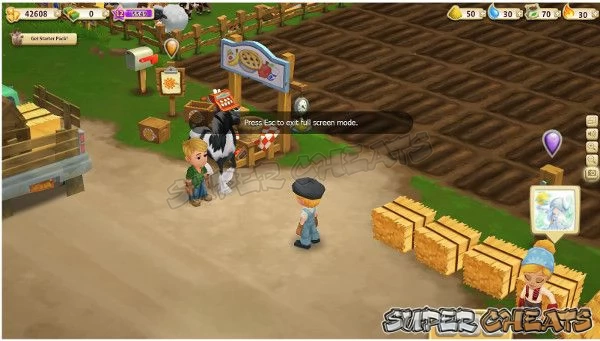
The first of these lessons is to take care in how you lay out your new farm, because unlike the world of Farmville where form followed function, in Farmville 2 there are actually strategic advantages to how you choose to lay out your world. In simple terms, Organization in this game pays dividends. There are key objects you will be using and re-using, and if you start from the beginning with an eye towards compartmentalization of the different elements, by the time that becomes crucial as part of your basic and advanced Strategy you will be doing it automatically.
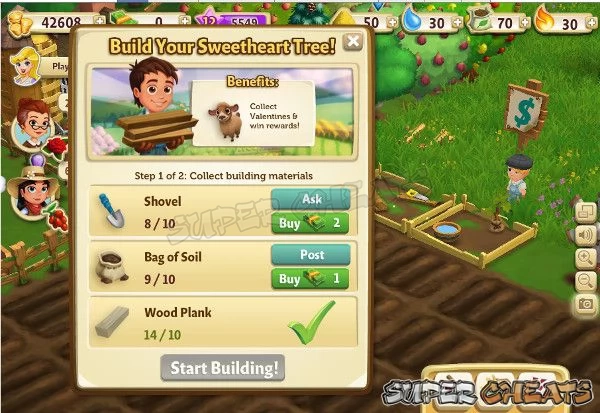
Interface Changes
The Graphical User Interface: The graphics and the user interface in Farmville 2 have been created with an eye towards expanding the presence of animation as part of game play. This has been done with a discrete eye towards making the change part of the entertainment formula, and as a result the animated sequences are presented with a personal perspective whose focus is your player-character. That is a good thing, mind you, because this is now a game that, for better or worse, centers around that character.
Core Changes
Crop Resource Costs: Farmville as a series is a game that is first about growing crops, and second about everything else. The crop cycle in Farmville 2 consists of:
(1) Plant – (2) Water – (3) Fertilize – (4) Timer – (5) Harvest – (6) Storage – (7) Use.
While it may appear to be similar to that of the original it is not. In fact it is very different and the differences are impactful in more ways than may at first be evident. Compare the above to the old system:
(1) Plant – (2) Timer – (3) Harvest.
To help you understand the impact that this fundamental change has, we will examine each of the new steps and contrast them to the old system where that applies...
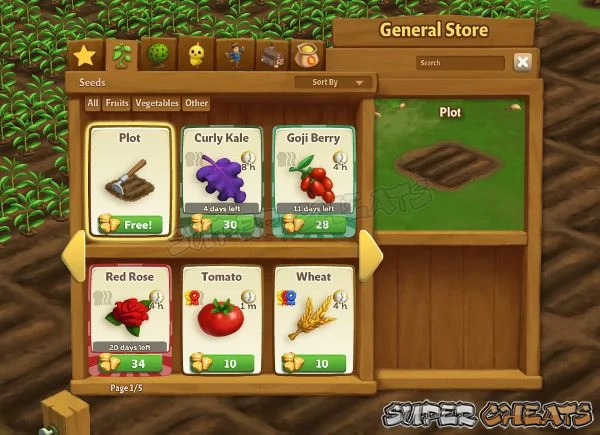
(1) Plant
Once the farming area has been prepared, with designated crop squares in place, the player selects from the list of available seeds based upon their level or any Special Events, and then plants them in much the same fashion as in the previous game, either by opening the menu system and selecting the desired seed or by clicking on a fallow crop square which results in opening the menu system automatically and allows the player to select the desired seed.
Once the seed is selected, the pointer is then charged with the ability to plant it whenever the player left-clicks on a fallow crop square. Bear in mind that simply planting the seed, unlike in the previous game, is only the first step in the process, and planting alone does NOT initiate a crop.
When the player clicks on a prepared crop square, the state of the square is altered to represent that it has been planted with the selected seed, at which point its condition changes to “In Need of Water” and that is as far as the crop process goes without additional intervention on the part of the player or one of their mates.
In simple terms the seed is planted and a water requirement icon is added above the crop resource square, which can only be removed and thus the growth system progressed by applying water to that resource square. See the next stop for more detailed information about that process.
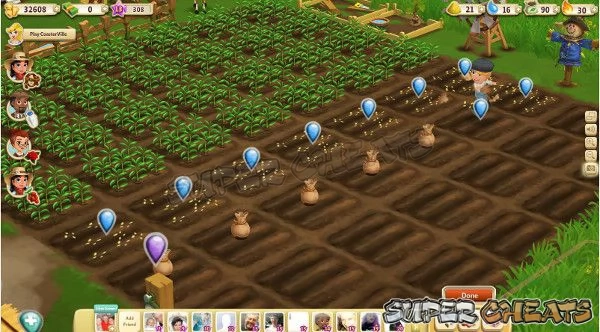
(2) Water
The game is structured for the storage of a finite number of resources, and the resource that is important for this part is water. Water is obtained in one of five ways: by (1) Time the resource inventory for your character has its water (and other) useable and necessary resources refilled;
by (2) Player Action, the stored resources can be refilled by direct player action in the form of either clicking upon and harvesting the water units in a well, or by clicking upon and harvesting the random water resources that can be obtained through visits to the farms of your neighbors/mates, when you use one of the five available daily assistance Actions by clicking on a water well or a water trough.
In addition to the above sources, a random number of dingle water resource units will be awarded to the player for completing the five available assistance Actions on a per-neighbor, per day basis. That is to say when you complete helping your mate having visited their farm, there is a random chance that among the rewards you receive for doing so in addition to coins and/or XP will be a single unit of water resource, awarded as part of the summary after you complete the fifth assistance action;
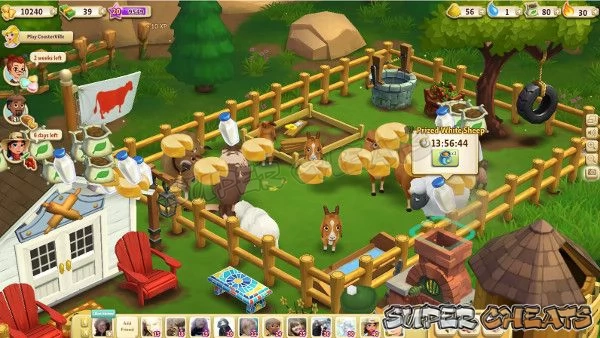
(3) Fertilize
The game will award the player with Fertilizer resource units for a number of independent Actions, the more common of which is the harvesting of an appropriate farm animal. When the player harvests a goat, cow, horse, rabbit, and other related farm animal, there is a chance that they will receive as part of the harvested resources one or more bags (units) of fertilizer.
As with all of the other types of player-useable resources, the player is permitted to retain a bank of X number of resources, by type, and in the case of Fertilizer that bank consists of no more than 100 units. The current capacity of available resource units can be found on the top right of the game interface, and include, from left-to-right, Animal Feed, Water Units, Fertilizer, and Power Units. To determine what the maximum amount is that the player can store at any time simply mouse-over the display on the top right for a pop-up summary that includes that information.
An important factoid to consider when you are stockpiling resources in the game is that any resource that is actually gathered within the game is subject to the limitations of the resource bank rules – that is to say for example that if you already have 100 units of Fertilizer and you feed your animals, thus producing an additional 10 units of Fertilizer, those units are lost when you collect them due to the fact that your current resource bank is at capacity for that resource. On the other hand if you are surfing the Game Feed in Facebook and you collect a resource like Fertilizer, even when your in-game resource bank is at capacity, you still receive the resource that you collected from the Feed, but in the form of a package inside your game storage locker (the red and white box in the bottom right-hand corner of the game play interface that represents your Inventory).
If you are out of a resource that you need – meaning that your resource bank reads that it contains none of that resource – check your Inventory for stockpiled Feed-based resources. These will appear in your Inventory in the form of single units that stack to a maximum of 30 units for each resource type. Each time that you click on a resource from that saved stack one unit is deducted and added to your active resource bank in the game. This can be a tremendous advantage to you, so it should be one of the secondary choices that you make when surfing the feed, the idea being to build up a reserve in Inventory of 30 of each type of resource just so you have them.
Note that his does not apply to resources that ordinarily are only found in your Inventory – such as Baby Bottles – which are valuable to the point that you want to make sure to use some to open slots in the Inventory in order to collect additional units from the Feed. Other resources that are considered to have significant value, and thus are among the Inventory Items that you should be keeping track of as a general rule, include Bricks, Brown Sugar, Salt, Sugar, Wood Planks, all of which have a cap of 12 in total. Metal Ingots have a cap of 16. Bottles of Clove, which are useful in Crafting, allow a total of 15 to be stored in Inventory. Water, Fire, and Fertilizer have a cap of 30 units in Inventory. Tools that are used for special construction projects, including the Hoe, Shovel, and Pick, generally have a cap of 13 in storage and are good to have since they make future construction projects easy to complete. We cover all of this later in the Strategies sections in some detail.
In addition to obtaining Fertilizer from your animals that produce it in abundance as a side-effect of eating the feed that you give them, you can also obtain Fertilizer in smaller quantities as part of the reward for assisting your neighbors – for example, when you fertilize a neighbors crops there is a random chance to obtain a unit of fertilizer from each resource square that you fertilize. When you make use of the visiting neighbors who have agreed to provide labor to your farm (the ones that are found on the hay bales in the bottom right of the screen and NOT the ones who chose to help you who appear as wandering visitors) the result of their servicing a crop in your field is usually at least one unit of Fertilizer in addition to the assistance that they provided you.
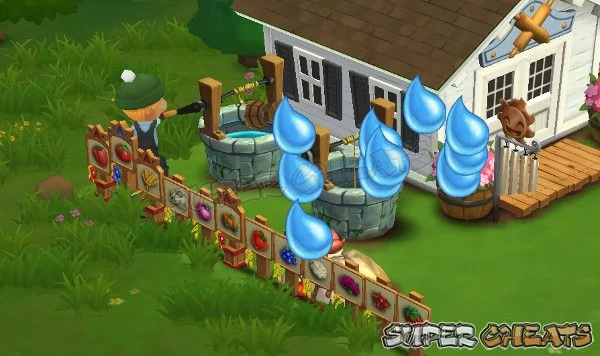
(4) Timer
The second element that the new game shares with the original is the fact that each crop has its own timer that must run out for the crop to reach the harvesting stage. As a general rule the more valuable the crop, the longer that the timer is, but this also applies to value of crops in Crafting, bearing in mind that crafting in Farmville 2 has taken a much larger and more obvious role than it did in the previous game.
(5) Harvest
While the previous title in the series including the harvest, in Farmville 2 harvesting your crops has a very different effect entirely. Players familiar with the original Farmville will recall that once the timer had completed on a crop they then harvested it, with the resulting income that was generated going directly into their bank account in the game. That is not how it works in Farmville 2 at all, as the game now treats the crops in a more realistic manner than previously, with the harvested produce being instead of sold outright, placed into storage.
The player then has the choice to make use of the harvest as they see fit, applying it in any of the several ways that it can be used, which are as follows:
(A) Selling the Crop: This can be accomplished by selecting the Farm Market Stall that is located on the bottom left-hand-side of the game window, and conveniently enough includes scales, baskets, and a cash register for ringing up purchases.
When the player opens the Market Menu they are presented with access to the produce storage system that is built into the game, which takes the form of 48 Storage Slots, each of which can contain a single type of crop, which includes the crops grown in the field as well as the crops harvested from trees, but also includes crafted Items created by the player in the Farm Kitchen and Workshop. In addition to the produce and crafted items, the Market Stall storage also contains any raw materials and resources that are obtained from farm animals as well.
It is important that this be well-managed by the player because once the storage system is filled the player runs the risk of losing income and resources. Fortunately there are so many other things that can be done with the resources contained in it that the likelihood of that happening is small, however the player should refer to the specific section on Strategies for Resource Management for more information on the subject.
(B) Feed Mill: One of the most common uses for crops is to process them via the Feed Mill in order to convert them into Animal Feed, which is something that the player will be doing on a regular basis and as needed in order to keep their animals fed. This is positioned as the second order of use for a reason; not only is it one of the most frequent uses for crops in the game second to selling, it is also a very important strategic element in that it reminds the player constantly that they need to both plan ahead and maintain a reserve supply of crop resources for use both as feed and for Crafting.
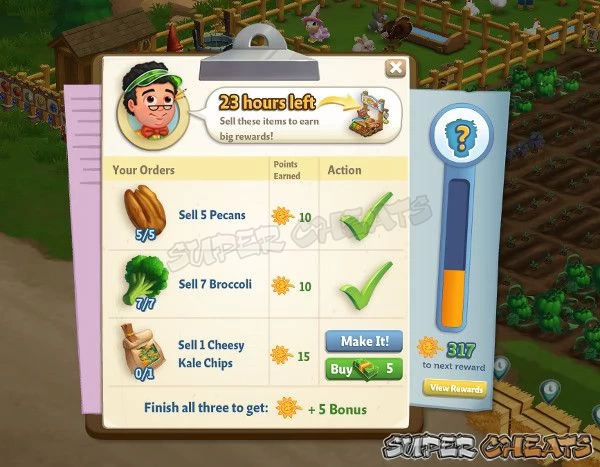
(C) Village Grocer Order Board: The third most frequent use of crops and resources is filling orders that are placed by the Village Grocer, which appear in the game in the form of three Items requested by the Grocer via the Order Board, which is placed to the left of the Market Stall.
The player should be checking the Order Board at least once during each play session to determine if there are Items on it that they can fulfill. Bearing in mind that in addition to being a good source for XP in the game, the Order Board can also provide you with direction and goals during the rare periods when, for whatever reason, there are no active quests available to direct your play. In addition to gaining XP and income, accumulating the required points for each level of the Grocer Order system will result in unlocking special rewards, among which are the mosaic bench decoration, and larger quantities of resources.
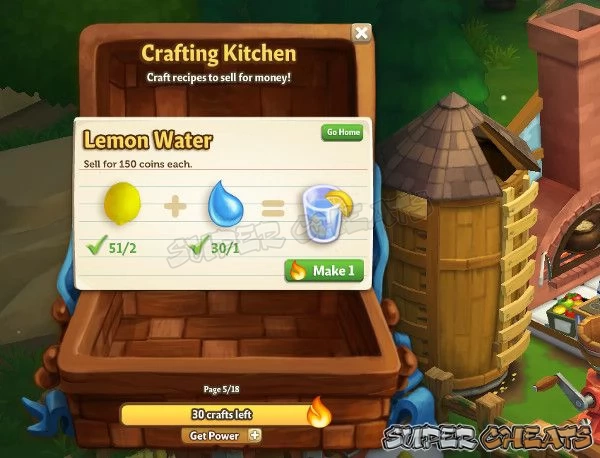
(D) The Farm Kitchen: This is the original Crafting mechanism that was rolled out at the initial launch time for Farmville 2, and prior to the release of the Workshop was the sole crafting destination in the game and one of the obvious ways that the produce you grow can be used. For detailed information about that, refer to the Crafting Section, but in general there are a number of crafting recipes that are available that should be routinely used in order to consolidate the stored resources in a manner that enhances their value. Those include the following subtypes of recipes.
Basic Resource Recipes - Used to create Intermediate Recipes
- Apple Juice: x4 Apples + x1 Water = x1 Apple Juice (Value: 260c per unit)
- Batter: x1 Flour + x3 Eggs = x1 Batter (Value: 290c per unit)
- Butter: x1 Milk + x1 Milk = x1 Butter (Value: 180c per unit)
- Carton of Red Eggs: x3 Red Eggs + x3 Red Eggs = x1 Carton (Value: 1100c per unit)
- Corn Meal: x4 Corn + x4 Corn = x1 Corn Meal (Value: 230c per unit)
- Flour: x2 Wheat + x2 Wheat = x1 Unit (Value: 90c per unit)
- Lemon Water: x2 Lemon + x1 Water = x1 Unit (Value: 150c per unit)
Intermediate Resource Recipes - Recipes that can be used in making other Recipes
- Broth: x3 Water + x6 Onions = x1 Broth (Value: 420c per unit)
- Buttermilk: x1 Butter + x3 Milk = x1 Buttermilk (Value: 450c per unit)
- Crate of Eggs: x5 White Eggs + x5 Brown Eggs = x1 Crate (Value: 1000c per unit)
- Custard: x2 White Eggs + x1 Milk = x1 Custard (Value: 240c per unit)
- Dough: x1 Flour + x2 Water = x1 Dough (Value: 240c per unit)
- Lemonade: x1 Lemon Water + x4 Lemons = x1 Lemonade (Value: 350c per unit)
- Tomato Paste: x4 Tomato + x4 Tomato = x1 Tomato Paste (Value: 120c per unit)
The examples provided above should give you a general idea of the two basic types of recipe that exist complimentary of the more complex and involved primary goods and their recipes. The important point here is that the above two classes of recipe can be made even when the player does not have a primary recipe in mind, and thus stockpiled with no negative consequences.
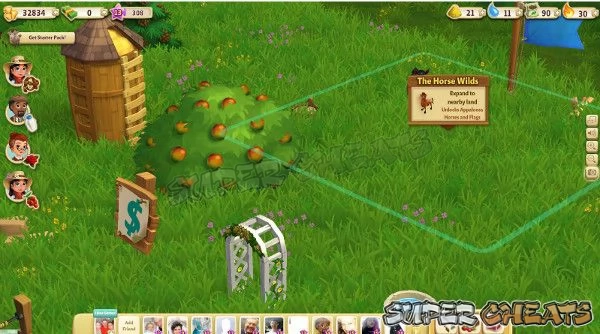
The reason that the player would want to do this is both because it creates a supply of stored recipe components (and thus a use for the different resources the player creates) as well as allows the player to use the available Power that is part of the regular resource bank as well as utilizing the Furnace for an additional ten units of Power, collectively permitting the player to obtain the benefits of these renewable resources while at the same time collecting the XP their use generates.
The reason that the recipes above have enhanced value has to do with the fact that they are common elements in more advanced recipes. For example the Lemon Water is used to create Lemonade, which is in turn used to make other flavored beverages like Strawberry Lemonade, Goji Berry Lemonade, Blood Orange Lemonade, and Peach Lemonade, which means that there will never be a shortage for its demand.
Flour is used as a component in a wide number of recipes – most of the baking ones in fact – and any recipe that allows for combining raw resources such as the Crate of Eggs and Carton of Red Eggs permits you to consolidate their storage while enhancing value. The latter two are also called for in various recipes, so creating them in advance allows the player to make use of power in Crafting that otherwise may go unused. Ultimately it is the ability to collect the XP that is part of the reward for crafting that is the primary focus.
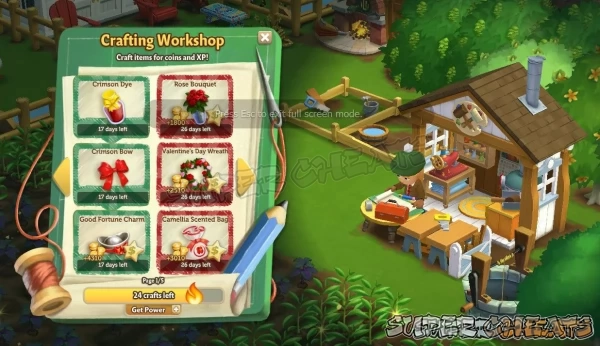
(E) The Farm Workshop: Access to the Workshop is gained via the related special event quest series that began with the player being prompted to place the Workshop construction site. Please be aware that the Holiday Workshop Quest Series and this one are two different quest lines.
The Crafting Workshop Quest is added to the game upon log in to the game client, at which point the player is prompted to place the Workshop construction project. After placement the quest opens to reveal that the player will need to supply the following materials in order to complete the construction of the Crafting Workshop building:
- x8 Pressure Gauges (Requested from mates or purchased for x8 Farm Bucks)
- x8 Drafting Papers (Requested from mates or purchased for x8 Farm Bucks)
- x8 Wooden Planks (Requested from mates or purchased for x8 Farm Bucks)
Ideally the player will have requested the Pressure Gauges and Drafting Paper form their mates, and have had a supply of Wooden Planks in their storage (Inventory) since that is a resource that can be stockpiled. Once the three resource groups are unlocked, the player is then prompted to either pay for assistance in assembling the resources and other implied materials into the Workshop building, or they will have requested the assistance of four of their mates (the preferred method). Either way once that is accomplished the fifth most popular channel for the use of resources has been completed!
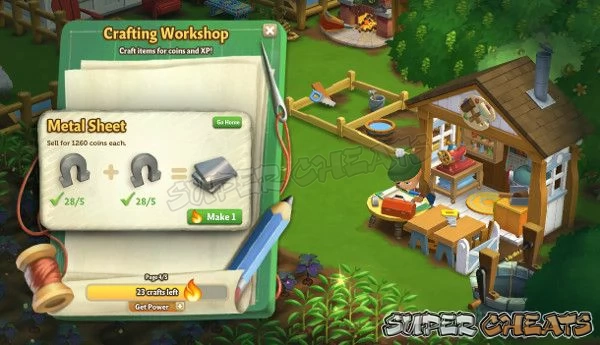
When the Crafting Workshop is completed the player can then begin using it to create Items that can be sold or used to decorate their farm - items that are constructed using resources that are created by the player, utilizing one of the three primary sub-groups for which the Workshop is equipped to craft: The Workbench, The Loom, and The Blacksmith, all three of which utilize resources that are obtained on the farm either and based upon recipes that are level-dependent. More and detailed information can be found in the Crafting Section, however it should be noted that the primary focus for the Workshop really is narrowed in on Holiday and Quest Crafts, a sampling of which includes:
- Blueberry Dye: x8 Blueberry + x2 Flask = x1 Blueberry Dye (Value: 470c per unit)
- Crimson Dye: x2 Flask + x4 Goji Berry = x1 Crimson Dye (Value: 1050c per unit)
- Lumber: x4 Log + x4 Log = x1 Lumber (Value: 1260c per unit)
- Metal Sheet: x5 Horseshoe + x5 Horseshoe = x1 Metal Sheet (Value: 1260c per unit)
- Olive Oil: x12 Olives + x3 Flasks = x1 Olive Oil (Value: 1220c per unit)
- Rose Bouquet: x3 Flask + x12 Red Rose = x1 Rose Bouquet (Value: 1800c per unit)
- Wool Bolt: x4 Wool + x4 Wool = x1 Wool Bolt (Value: 630c per unit)
- Wool Thread Spindle: x6 Wool + x2 Wool Bolt = x1 Wool Thread Spindle (Value: 700c per unit)
The recipes that were selected to be included above are intended to illustrate for you how a wide variety of previously useless resources are now very useful – and when you carry out the logical application of these resources with an example such as the Dyes, which can be created and then applied to the Wool products to create different colours, you should get the idea.
The general reaction for most players at the release of the Crafts Workshop can be summed up nicely with the following Tweet from my daughter: “OMG YES! Finally there is something to do with all the bloody wool I have been harvesting from by sheep and rabbits! Yes!”
As the above clearly demonstrates, the new Crafting system is not so much a revamped version of the old system in Farmville, but an entirely new and unique system that has been subtly shaped by the new focus upon the player-character in the game, as well as the need to make a more realistic use of the many and sundry resources that are created on a working farm in a way that is more meaningful and more profitable.
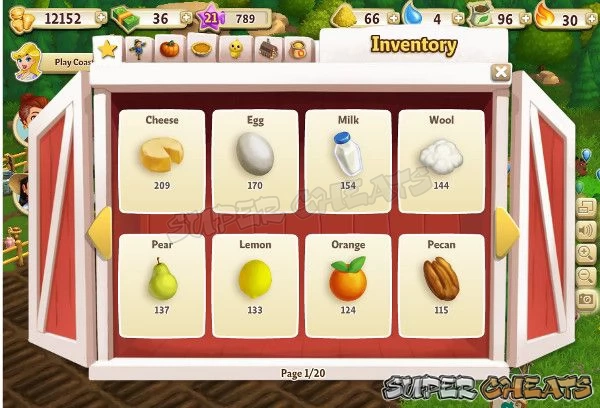
(6) Storage
Whether we are talking about animal-based resources or harvested crops, as each is collected it is placed directly into the farm storage system, which can be accessed in two ways: via the Inventory System which is activated by clicking on the button depicting the red-and-white wooden crate/box on the bottom right-hand side of the game screen, or via the Farm Stand in the center left of the bottom of the game screen.
Inventory: the resources are stored in the character Inventory and when they are accessed via the Inventory what you see is an icon representing that resource and its current count. If you look at the image embedded above at you will note that the inventory of resources as presented here includes x209 Cheese, x170 Egg, x154 Milk, x144 Wool, x137 Pear, x134 Lemon, x124 Orange, and x115 Pecan.
(7) Use
The final stage in the resource production line us use. At this point there are a number of options available to us – we can make Animal Feed with some of the resources, sell some or all of it at the Farm Stand for coins, use it for Crafting either in the Workshop or in the Farm Kitchen, or use selected Items from our Inventory to fulfill the Village Grocer orders. The point to this is to emphasize that unlike the mechanism that was operative in the original Farmville, in this game we have options. And how cool is that?
Now that we have covered all of the various aspects of things we can do and Actions that we can take with the various resources that we have created, there is one more option that should be addressed, and that is to do nothing at all!
Seriously!
The resources are now safely stored in our Inventory and with the exception of specific special resources such as the building materials, collection Items, and rare Crafting items, there is no cap to what we have stored for resources, and we are under no obligation or pressure to use or sell them. In point of fact maintaining an inventory or supply of most of these resources as a reserve is actually a very smart thing to do!
So prior to setting out to dispose of the resources that you worked so hard to create, it is a good idea to review what you have and take a peak into the future to get an idea for what you might need. Bearing in mind that you are always going to need resources to make Animal Feed, and the fact that you have no way to predict what the next new quest down the road will require, it would be an idea to retain around x100 of the core resources – the important ones in other words – as an operating ready reserve.
For our purposes here we would consider any crop that takes longer than six hours to be a candidate for designating as a reserve crop, and thus we would want to keep a supply on hand.
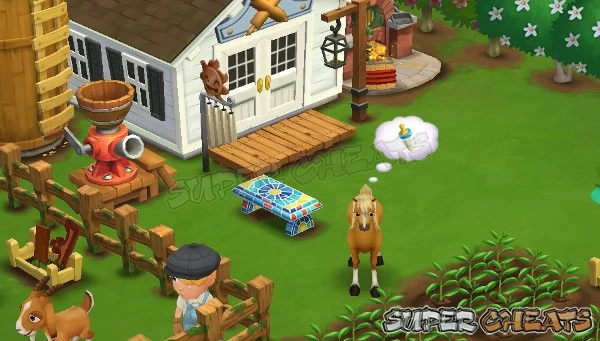
Prized Animal System: When Farmville 2 first released it did not include the Prized Animal System that is now in place, and which kicks in after you feed an animal X number of times. When the animal makes the transition from regular resource producing animal to prized blue ribbon go-to-the-county-fair and win you coins and XP non-resource-producing version, that leaves the player with a decision to make. Keep the prized animal or sell it?
Bearing in mind that your farm is limited to a specific maximum number of animals, many players considered the Prized Animals to be a waste of space, and would sell theirs off as soon as it matured to the prized stage. In response to this, Zynga modified the prized animals so that while they no longer produced the original resources which you bought them to create, after they become prized they begin to produce Premium goods and resources, so hey, win-win.
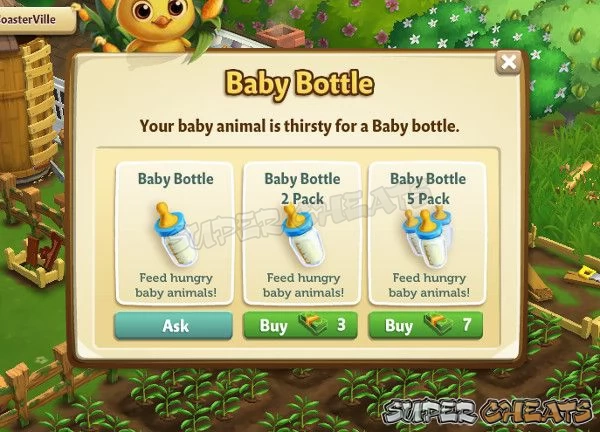
The following comparison list will give you an idea of the differences between the regular and the premium resources that these examples produce:
Animal: Regular Resources (Premium Resources)
- - - - - - - - - - - - - - - - - - - - - - - - - - - - - - - - - - -
- Chickens: White Eggs, Fertilizer (Brown Eggs)
- Cows: Cheese, Milk, Fertilizer (Swiss Cheese)
- Goats: Milk, Cheese, Fertilizer (Goat Cheese)
- Horses: Horseshoe, Fertilizer (Fine Saddles)
- Rabbits: Wool, Fertilizer (Fine Wool)
- Sheep: Wool, Milk, Fertilizer (Fine Fleece)
- Turkeys: Brown Feather, Fertilizer (White Feathers)
Now all of the different types of animals of a particular type produce the same Items in the same quantities, as there are variations depending upon cost, but you should get the general idea from the list above.
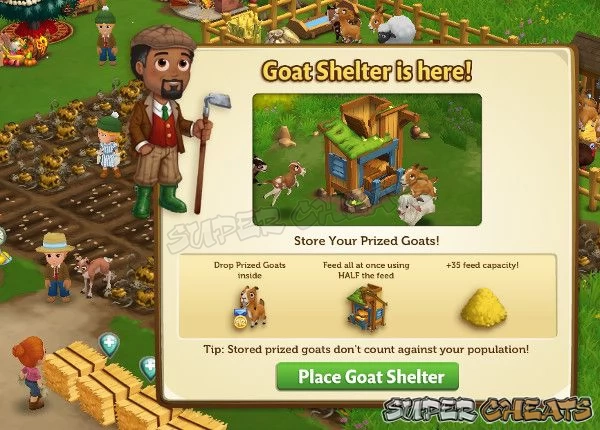
Animal Capacities: The number of animals that can be owned by the player is based upon several limiting factors, but the capacity limits can be increased by building additional structures like water troughs, the Shady Trough, and the like.
A new structure has been introduced into the game, the Prized Chicken Coop, which allows the player to store up to nine Prized Chickens inside of it, and harvest it as a unit. By placing the Prized Chickens inside the Prized Chicken Coop these Prized Chickens are removed from the total number cap for animals on the farm, which allows the player to add additional animals to their farm while enjoying the benefits of the previously leveled animals.
The rumor that has been circulating about additional Prized Animal Buildings to be added for each of the types of animals in the game has now been confirmed by Zynga in the form of the newest building to the game, the Goat Shelter! Functioning in a similar fashion to the new Chicken Coop, the Goat Shelter allows for the storage of up to 12 Prized Goats, allowing the player to benefit from their advanced levels while removing the 12 goats from the animal cap.
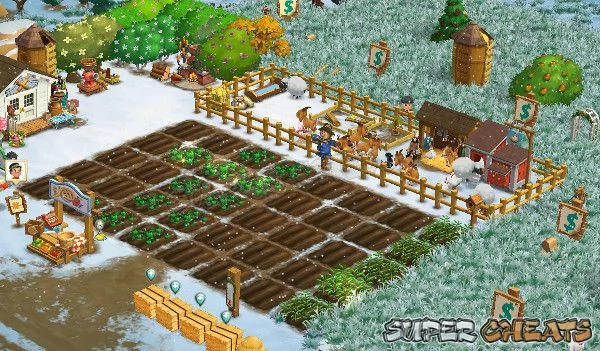
Special Event Content Expansion: While Farmville 2 is maintaining the tradition of adding special Holiday Events to the game, a tradition that was established in the original Farmville, the mechanism that is being used in the new game is very different than that of the old in that these Special Events are structured as content expansions that, unlike the original game, remain active after the holiday event ends.
As a result when the player was participating in the holiday or special event expansion program and the event ends, they still have the option to complete whatever event-related structure they were last working on. In the previous version the end of an event essentially canceled all incomplete event-related building, whereas in the new game the player has the option to continue building it until it is completed.
In addition to the enduring content, most of the crop and resource-based expansion content is placed on timers.
Anything missing from this guide?
ASK A QUESTION for FarmVille 2
Comments for New Version Changes
Add a comment
Please log in above or sign up for free to post comments- Introduction
- New Version Changes
- The Plight of the Small Farmer in Farmville
- Starting Tips, Tricks, Strategies, and Good Game Play Habits
- The Farmville 2 Economics Overview
- Establishing Good Play Habits
- The Missions and Quests Primer
- Known Bugs and Server Issues
- Current and Recent News
- Walkthrough / Guide
- Reference Sections
- Structures
- Special Events
- Addendum
 Join us on Discord
Join us on Discord

I wonder what to do to be able to give not one but full of bottles, that a baby needs in order to become an adult ... because that on my farm not received this update
not sure i like the new fair every week i have been 3rd place now i am lucky to make it to 8th whats up with that
[color=red][color=red][/color] [/color]
I have no answer for this. I'm just happy to hear someone else speak on this besides me. I hope that there's a way that zynga can resolve this situation.
hi ya, i need a good few blurb sheets any ideas how to get it?
I'm looking for info on "rare treats" as well. Someone asked about storage, well, most stuff is unlimited to begin with but NOT water, feed, baby bottles, etc. For feed, buy silos and animal (prized) houses. water, you can improve your supply with additional wells and water towers (got to have 4 wells 1st). Last I heard, the limit always is 30. Baby bottles and other limited objects, I'm still working on those. Enjoy.
i need cheats
How do I buy storage
Rare Treats for animals, where and how do you get them?
How to feed 4 goats to stockpile some milk
this is an old page but I am wondering if you have any info on the 'special treat' needed to get the milk carton from the cows??
D #288138,
hay i need cheats i don't want to get explanation of the game